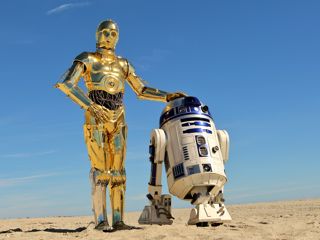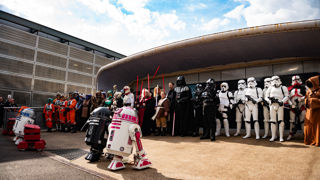
Galactic Droids
- 26th Jun 2025
- Author: Emma Mosley
A short time ago in a Space Centre not far, far away… our staff have been getting ready for our annual out of this world ‘Galactic Gathering’!
Star Wars can be described as a Sci-fi Space Opera franchise, minus the singing! Starting with the first film Episode 4: A New Hope in 1977, it now spans across multiple films, TV series, books, merchandise, and more. It is a tale of good versus evil influenced by a mysterious and mystical energy called ‘the Force’. Within the galaxy there are numerous alien civilisations including humans, but there are also lots of droids!

What is a 'Droid'?
‘Droid’ is a trademarked name by Lucasfilm for the name of their robots within the Star Wars franchise. It is from a shortening of the word ‘Android’, meaning a robot resembling a human.
In the Star Wars universe, these droids are in different classes depending on their job, though they are always classed below organic life. They contain AI intelligence and have their own language called Binary. They perform a multitude of jobs from construction to repairs to navigation and more! This means their designs are quite varied from humanoids to rovers to probes that hover.
Unfortunately these droids don’t exist in our world but it would be amazing if they did. So I have found five robots that have been into space that may seem familiar to you.
Here are the droids you are looking for…
1. DUM-series Pit Droid and Dextre
DUM Pit Droid
The DUM Pit droid is a repair droid manufactured by Serv-O-Droid Inc. They are cheap, expendable and durable so it’s no surprise they are handy mechanics on the podracer teams. First seen in Episode I: The Phantom Menace during the podrace on Tatooine and then throughout the franchise including at Peli Motto's garage in Mos Eisley in The Mandalorian.
DUM Pit droids are humanoid in shape with two arms, two legs and a head. These helpful droids can perform simple repair tasks including ones that would be extremely dangerous! With their fearless personalities they can reach places too difficult and dangerous for organic lifeforms. They do have a tendency to create wobbly pyramids when working together in larger numbers!
Dextre
Dextre is a versatile robot that has been performing maintenance on board the International Space Station (ISS) since 2008. Designed by the Canadian Space Agency, it can sit at the end of the Canadarm2, a large robotic arm, as well as move around the ISS on the Mobile Base System. Dextre can install or replace small equipment, remove broken parts in electrical systems, as well as test new tools and robotic techniques.
There are seven joints on each of its two arms allowing a large range of motion creating more complex movements than a human arm. Each hand has a range of tools available and a camera for the astronauts and engineers on the ground to see. By having Dextre on board the ISS, it has saved the need for countless spacewalks by astronauts, saving time and helping to keep the astronauts safe.
2. R5-D4 and Curiosity
R5-D4
R5-D4 is an astromech droid with a cylindrical head and body with three legs. Astromechs were designed to be mechanics for starships but could co-pilot starfighters and calculate the jumps through hyperspace. They communicate using Binary through clicks and beeps to other droids and organic lifeforms. Not all astromechs stay as mechanics or co-pilots, and instead go on to have their own adventure! A friend of R2-D2's, R5-D4 or just R5, also assisted the Rebellion by helping R2-D2 be bought by Luke Skywalker's uncle.
Later on, R5 was bought by Din Djarin (from 'The Mandalorian'), to help him find the Living Waters on the planet Mandalore. When they arrived, Din needed to find out if the air was breathable. R5 went tootling off to find out but then disappeared off the tracker! When Din had rescued R5, he saw that the air sample taken confirmed the air was breathable. A truly adventurous astromech!
Curiosity
Curiosity landed in the Gale Crater on Mars in 2012 and was the largest rover ever sent at the time. While trundling around on Mars, Curiosity has been running a range of experiments to try and find out if Mars ever had the conditions for life. One of the instruments onboard is called the Sample Analysis at Mars or SAM. It has a Gas Chromatograph and a Quadruple Mass Spectrometer which help identify and measure the gases in the atmosphere of Mars. By continuously taking measurements over time, scientists can build a picture of the atmospheric conditions of Mars.
To help scientists on the ground, when they are out of contact with Curiosity, is an AI called Autonomous Exploration for Gathering Increased Science or AEGIS. Whilst waiting for a new set of instructions, the AEGIS targets rocks to zap with the laser and analyses them, saving a lot of human work hours. It provides them with data straight away to help select new areas of interest.
Did you know? Curiosity even sang itself Happy Birthday on its first birthday! It's a Martian rover with personality and likes to be helpful. That sounds a bit like R5-D4.
3. Astrobee and MSE-6 Repair Droid
MSE-6 Repair Droid
MSE-6 Repair Droids are little boxes on wheels that are used for the upkeep and internal communications of bases and starships. We saw them for the first time in Episode IV: A New Hope on board the Death Star and are a staple droid within the franchise. They are also known as mouse droids because they are tiny, get frightened easily, and move quickly.
Their main role is to make repairs, clean floors, guide troops around, and carry top secret messages around in their command order tray. They also have a data probe and a grasping claw to assist in its work. These cute droids also help with security as R5-D4 found out by being zapped when trying to help Din Djarin to break into an Imperial Base.
Astrobee
Astrobee is not one robot but three! They are cubed shaped robots called Bumble, Honey and Queen. They were sent up to the ISS in 2019 along with their charging dock and accessories. These three busy bees were designed to assist astronauts in their day to day duties freeing up time for the astronauts. They can do lots of helpful things like documenting experiments by videoing the astronauts, working together to move cargo around, take inventories, and have a platform fitted to take part in experiments themselves!
To move around, the Astrobees use electric fans for propulsion and have an arm to perch and grab things. To see where they're going and to navigate, they have cameras and sensors. The aim for the future is that they can become caretakers of spacecraft by monitoring and maintaining systems whilst the human crew are away.
4. BB-8 and SORA-Q
BB-8
BB-8 is a fan favourite appearing in the films Episode VII: The Force Awakens, Episode VIII: The Rise of Skywalker, and Episode IX: The Last Jedi. It is a BB series astromech droid and is fitted with six circular tool-bay disks full of tools to complete any task he may face. Its body is spherical and can move in all directions by rolling around with its head held in place with magnets. During the films it belongs to the Resistance pilot Poe Dameron and helps him with his missions in the Resistance. BB-8 is very loyal to Poe and even saves his life on multiple occasions!
SORA-Q
Japan became the fifth country to have a soft landing on the Moon in January 2024. Their successful mission was called the Smart Lander for Investigating Moon (SLIM) which also had two robots onboard. As SLIM was about to land on the Moon, it dropped the two robots first before landing. One of these was the Lunar Excursion Vehicle 2 or LEV-2 also known as SORA-Q. It was a technology demonstration robot looking at lunar landing techniques to help study the Moon and other planets. SORA-Q was no ordinary robot, it was spherical in shape and rolled around on the Moon taking pictures.
When SLIM landed there were issues with the batteries not charging which were caused by it landing nose-first. Scientists found this out by SLIM's loyal friend SORA-Q moving towards SLIM, taking a picture and sending it back to the scientists.
5. C-3PO and Kirobo
C-3PO
C-3PO is a Protocol droid, which was designed to communicate with organic lifeforms and droids. Protocol droids are programmed in etiquette and are equipped with a TranLang III communication module, making them fluent in over 6 million forms of communication. This makes the Protocol droid vital for assisting diplomats, politicians and senators in their work. This leads to each droid having their own personalities, though for C-3PO, over time this made him quite fussy and a worrier. But we wouldn’t have him any other way!
C-3PO was rebuilt from spare parts by Anakin Skywalker when he was a child. C-3PO followed him on his adventures and ended up helping Queen Amidala with her duties in the Senate. When *spoiler alert!* Anakin turned to the dark side, C-3PO with his friend R2-D2 went to help the Rebel Alliance.
Kirobo
In August 2013, Japan sent a little robot called Kirobo to the ISS. His mission was to be a friend to the Japanese Space Agency, JAXA, astronaut Koichi Wakata during his stay onboard. JAXA partnered up with University of Tokyo’s Research Center for Advances Science and Technology, The Toyota Motor Corp., Robo Garage and Dentsu Inc. They wanted to design a robot that could talk to astronauts during long voyages in space and to study how this interaction technology could help with emotional support.
Kirobo has voice, face, and emotion recognition software as well as a camera and natural language processing. His look was inspired by the animated character ‘Astro Boy’ who is an android boy with human emotions. During his time onboard the ISS, Kirobo managed to achieve two Guinness World Records. He is the first companion robot in space and has the highest altitude for a robot to have a conversation in space at 414.2 km above sea level! We'll soon be having our own robotic companions by our sides on interplanetary travels!
As technology continues to develop and we push the boundaries of robotics, who knows what robots we may have in the future helping us. Let's hope they are just as varied and full of character as our favourite droids.
May the Force be with you!
Full Credits / References:
(Banner image) C-3PO and R2-D2. Credit: Darryl Moran CC BY-SA 2.0 (https://www.flickr.com/photos/dwmoran/21548629573)
(1) Galactic Gathering. Credit: National Space Centre
(2a) DUM Pit Droid. Credit: Chad Kainz CC BY 2.0 (https://www.flickr.com/photos/smaedli/54129189817/in/photolist-drikoa-8cJHpu-2qtdfip-9Y9ZzS-4RPNQW-2qvJfYk-cZBStb-2jQ7ZKx)
(2b) Dextre. Credit: NASA
(3a) R5-D4 rolling around with R2-D2. Credit: The Spirit of Cincinnatus CC BY-ND 2.0 (https://www.flickr.com/photos/thespiritofcincinnatus/15585369008/in/photolist-Znodvj-SYKm4u-SY44LE-RCfWKq-8dZ2v1-2VkLwN-2aB521p-cZ3buS-pKbTAS-pKbWgb-pK9HYR-q2zhyH-q2HtJ9-aKE7Fp-cgvT4y-pKe6dL-q2HwZs-p5PkDm)
(3b) Curiosity selfie from the surface of Mars. Credit: NASA/JPL-Caltech/MSSS
(4a) MSE-6 Repair Droid. Credit: Dick Thomas Johnson CC BY 2.0 (https://www.flickr.com/photos/31029865@N06/49639858396/in/photolist-dmNF5A-aVgJmr-drPHuY-ao7DhE-ZuwdZ9-x8QQYW-8mkdEs-2iCvftw-cnqGbf-2aB52pv-9mYxdc-anqJHc-antqcJ-TFa5Ao-9n2B5s-U1ubC3-fqw6KG-TFa3bU-U1u9sm-cZBWzu-68gZzf-9HFf1F-9HJ5AC-9HJESw-9HJ5dC-9HFPg8-cZByim-cZBVG7)
(4b) Astrobees with NASA astronaut Megan McArthur onboard the ISS. Credit: NASA
(5a) BB-8 from Star Wars. Credit: MBAnimalPics CC BY-SA 2.0 (https://www.flickr.com/photos/mbanimalpics/53150638247/in/photolist-2oYJV1B-2nGXUKL-XLcA4q-Y5GxoW-2ipTSRR-CgvBKp-Jwg574-CMeAX1-Y9TDMr-2jaTQJ1-26Kz5nw-RLBtHx-BRczVu-C8Kt4q-2h6N6FT-2jDqWuv-DrzhnZ-SYL5U9-FW3AmN-Aw1W5F-AaDigh-AaDnaj-2qhnzom-SkvoCW-2fNzRyU-CyJG5b-D75ayk-2iCvcFx-y37gpB-CcQU52-ykjoyH-ykjogZ-yiGw4m-VJ9EPY-dVwQAi-2iCwAnZ-TEvgzJ-yhiaSA-ETSvQq-Dxwizy-dgPHQJ-By2XYT-2kZqP4W-CNU4oV-FHs8sM-HsYayQ-TL3uZi-2jH8Evs-FPj4bz-EU4qbM)
(5b) SORA-Q on display at an event. Credit: テレストレラッソ CC BY-SA 4.0 (https://commons.wikimedia.org/wiki/File:SORAQ-FrontView.jpg)
(6a) C-3PO on Tatooine during a photoshoot. Credit: Darryl Moran CC BY-SA 2.0 (https://www.flickr.com/photos/dwmoran/22179916881/in/photolist-zMXSy2-dxgURk-zKWNA7-26aPTSv-HtNjXU-zKWDgq-GBfgTt-yQbo36-zKWKwS-bhgZbx-zuxPEV-zMZrua-zMW7rM-2r2A73h-zMVDHr-eCKDMx-zKVKys-zuDdwM-yPZ8DE-zM5Rix-zMWYAK-zuwCTX-zJJMY9-zJKr15-zNkM9w-zuvCXX-zupzQC-yQ1j1E-yQaxPH-zus9D7-mr6nzh-zuvHAe-zuun6s-WKLZK7-zQ7VUF-zNxdam-yPZuCU-zMVwM2-bpQDu6-zuyF44-yQ2tWu-yS36dD-zMVwb2-zurviC-zKZ6C9-zusx6o-zM4bda-zMVKba-yQ9dFK-zJGWFJ)
(6b) Kirobo robot. Credit: Takashi H CC BY-NC-SA 2.0 (https://www.flickr.com/photos/62942199@N08/11149169915)











